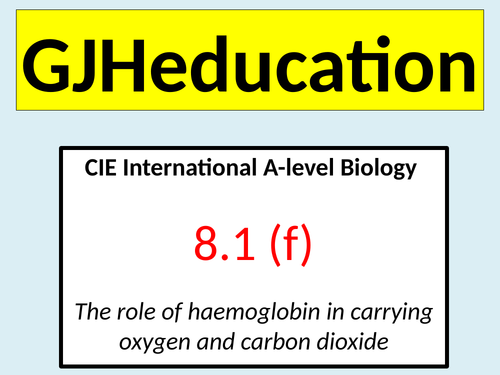

This engaging lesson looks at the role of haemoglobin in carrying oxygen and carbon dioxide. The PowerPoint has been designed to cover point 8.1 (f) of the CIE International A-level Biology specification and includes references to the role of carbonic anhydrase and the formation of haemoglobinic acid and carbaminohaemoglobin.
The lesson begins with a version of the quiz show Pointless to introduce haemotology as the study of the blood conditions. Students are told that haemoglobin has a quaternary structure and are challenged to use their prior knowledge of biological molecules to determine what this means for the protein. They will learn that each of the 4 polypeptide chains contains a haem group with an iron ion attached and that it is this group which has a high affinity for oxygen. Time is taken to discuss how this protein must be able to load (and unload) oxygen as well as transport the molecules to the respiring tissues. Students will plot the oxyhaemoglobin dissociation curve and the S-shaped curve is used to encourage discussions about the ease with which haemoglobin loads each molecule. The remainder of the lesson looks at the different ways that carbon dioxide is transported around the body that involve haemoglobin. Time is taken to look at the dissociation of carbonic acid into hydrogen ions so that students can understand how this will affect the affinity of haemoglobin for oxygen in an upcoming lesson on the Bohr effect.
Get this resource as part of a bundle and save up to 47%
A bundle is a package of resources grouped together to teach a particular topic, or a series of lessons, in one place.
Topics 7 & 8: Transport in plants & mammals (CIE A-level Biology)
This bundle contains 11 fully-resourced lessons which will engage and motivate the students whilst covering the following specification points in topics 7 and 8 of the CIE A-level Biology specification: TOPIC 7 * The structure of xylem vessel elements, phloem sieve tube elements and companion cells * The relationship between the structure and function of xylem vessel elements, phloem sieve tube elements and companion cells * Explain how hydrogen bonding of water molecules is involved with the movement in the xylem by cohesion-tension in transpiration pull and adhesion to cell walls * The pathways and mechanisms by which water and mineral ions are transported from the soil to the xylem and from roots to leaves * Assimilates move between sources and sinks between phloem sieve tubes * The mechanism by which sucrose is loaded into the phloem * The mass flow of phloem sap down a hydrostatic pressure gradient TOPIC 8 * The double, closed circulatory system of a mammal * The relationship between the structure and function of arteries, veins and capillaries * The role of haemoglobin in carrying oxygen and carbon dioxide * The significance of the oxygen dissociation curve of adult haemoglobin at different carbon dioxide concentrations * The external and internal structure of the heart * The cardiac cycle * The role of the SAN, AVN and Purkyne tissue in the initiation and conduction of the heart action The lesson PowerPoints and accompanying resources contain a wide range of tasks which include exam-style questions with mark schemes, discussion points and quiz competitions that will check on current understanding as well as making links to previously covered topics.
Topic 8: Transport in mammals (CIE International A-level Biology)
Each of the 7 lessons in this bundle are fully-resourced and have been designed to cover the content as detailed in topic 8 (Transport in mammals) of the CIE International A-Level Biology specification. The specification points that are covered within these lessons include: * The double, closed circulatory system of a mammal * The relationship between the structure and function of arteries, veins and capillaries * The role of haemoglobin in carrying oxygen and carbon dioxide * The significance of the oxygen dissociation curve at different carbon dioxide concentrations (Bohr effect) * The external and internal structure of the mammalian heart * The cardiac cycle, including the blood pressure changes during systole and diastole * The initiation and control of heart action The lessons have been written to include a wide range of activities and numerous understanding and prior knowledge checks so students can assess their progress against the current topic as well as be challenged to make links to other topics within this topic and earlier topics If you would like to see the quality of the lessons, download the arteries, veins and capillaries lesson as this is free
Something went wrong, please try again later.
Very detailed
Report this resourceto let us know if it violates our terms and conditions.
Our customer service team will review your report and will be in touch.